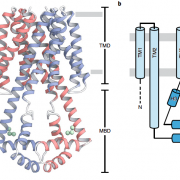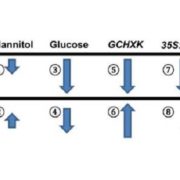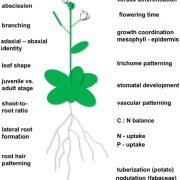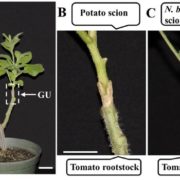Red Light and the Plasma Membrane H+-ATPase in Guard Cells
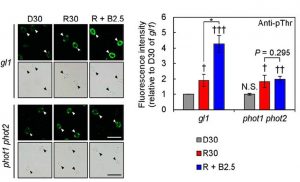 Stomatal opening is stimulated by light, including blue and red light. Blue light-induced stomatal opening is fairly well understood: it is mediated by blue-light photoreceptor phototropins (phot1 and phot2). Blue light activates the plasma membrane (PM) H+-ATPase via phosphorylation of its penultimate C-terminal residue. In addition, blue light induces starch degradation, resulting in the accumulation of sugars in guard cells. In Arabidopsis, all isogenes of PM H+-ATPase (AHA1–AHA11) are expressed in guard cells. Among them, AHA1 is the major isoform and is responsible for blue light-induced stomatal opening. Red light-induced stomatal opening, on the other hand, is thought to be dependent on photosynthesis in both guard cell chloroplasts and mesophyll cells; however, the mechanism by which red light induces stomatal opening and whether PM H+-ATPases are involved in this process are controversial. Ando and Kinoshita (10.1104/pp.18.00544)have established an immunohistochemical technique to detect the phosphorylation level of PM H+-ATPase in guard cells using whole leaves of Arabidopsis. Unexpectedly, they found that red light induces phosphorylation of the penultimate C-terminal residue of PM H+-ATPase in whole leaves and this process is inhibited by the plant hormone abscisic acid. Red light-dependent stomatal opening was delayed in whole leaves of aha1-9, a knockout mutant of one of the major isoforms of PM H+-ATPase in guard cells. Furthermore, the photosynthetic electron transport inhibitor, 3-(3,4-dichlorophenyl)-1,1-dimethylurea (DCMU), inhibited red light-induced PM H+-ATPase phosphorylation, as well as red light-induced stomatal opening in whole leaves. These results indicate that red light-induced PM H+-ATPase phosphorylation in guard cells promotes stomatal opening in whole leaves, providing insight into the photosynthetic regulation of stomatal opening.
Stomatal opening is stimulated by light, including blue and red light. Blue light-induced stomatal opening is fairly well understood: it is mediated by blue-light photoreceptor phototropins (phot1 and phot2). Blue light activates the plasma membrane (PM) H+-ATPase via phosphorylation of its penultimate C-terminal residue. In addition, blue light induces starch degradation, resulting in the accumulation of sugars in guard cells. In Arabidopsis, all isogenes of PM H+-ATPase (AHA1–AHA11) are expressed in guard cells. Among them, AHA1 is the major isoform and is responsible for blue light-induced stomatal opening. Red light-induced stomatal opening, on the other hand, is thought to be dependent on photosynthesis in both guard cell chloroplasts and mesophyll cells; however, the mechanism by which red light induces stomatal opening and whether PM H+-ATPases are involved in this process are controversial. Ando and Kinoshita (10.1104/pp.18.00544)have established an immunohistochemical technique to detect the phosphorylation level of PM H+-ATPase in guard cells using whole leaves of Arabidopsis. Unexpectedly, they found that red light induces phosphorylation of the penultimate C-terminal residue of PM H+-ATPase in whole leaves and this process is inhibited by the plant hormone abscisic acid. Red light-dependent stomatal opening was delayed in whole leaves of aha1-9, a knockout mutant of one of the major isoforms of PM H+-ATPase in guard cells. Furthermore, the photosynthetic electron transport inhibitor, 3-(3,4-dichlorophenyl)-1,1-dimethylurea (DCMU), inhibited red light-induced PM H+-ATPase phosphorylation, as well as red light-induced stomatal opening in whole leaves. These results indicate that red light-induced PM H+-ATPase phosphorylation in guard cells promotes stomatal opening in whole leaves, providing insight into the photosynthetic regulation of stomatal opening.



